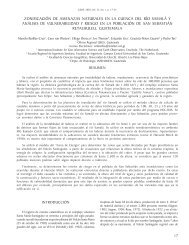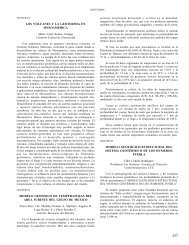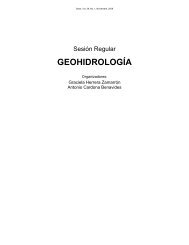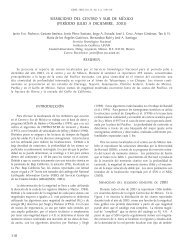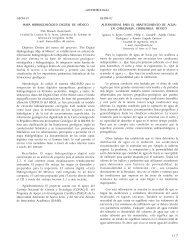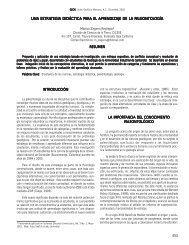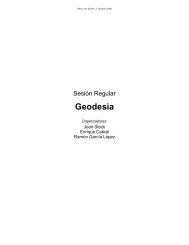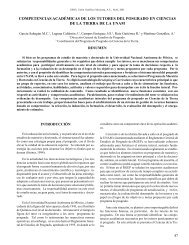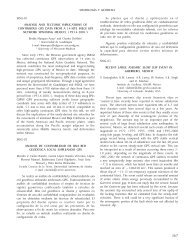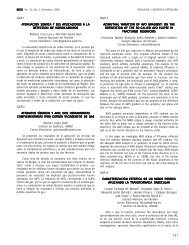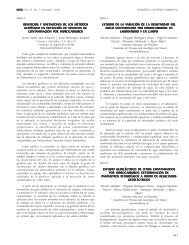Libro de resúmenes - Unión Geofisica Mexicana AC
Libro de resúmenes - Unión Geofisica Mexicana AC
Libro de resúmenes - Unión Geofisica Mexicana AC
You also want an ePaper? Increase the reach of your titles
YUMPU automatically turns print PDFs into web optimized ePapers that Google loves.
VARIABILIDAD CLIMÁTICA DEL CUATERNARIO EN REGISTROSCONTINENTALES Y MARINOSGeos, Vol. 31, No. 1, Noviembre, 2011during the last century. These conditions correlate with ENSO cycles, which havebecome more intense during the late Holocene.SE05-15RECONSTRUCTION OF OCEANOGRAPHIC CONDITIONS DURINGTHE PAST TWO MILLENNIA IN SOUTHWESTERN GULF OFCALIFORNIA BASED ON POLYCYSTINE RADIOLARIAN RECORDGómez Lizárraga Laura Elena 1 y Pérez Cruz Ligia 21 Instituto <strong>de</strong> Ciencias <strong>de</strong>l Mar y Limnología, UNAM2 Instituto <strong>de</strong> Geofísica, UNAMlaraluneta@gmail.comThe study of polycystine radiolarians assemblages record in a laminatedsequence of marine sediment from La Paz Basin, southwestern Gulf ofCalifornia (core K47; 145 cm lenght, 830 m <strong>de</strong>pth) suggest three scenariosof climatic and oceanographic conditions for the past two millennia. The firstone, shows important intervals at ~ AD 210 to 288, ~ AD 678 to 794, ~AD 1378 to 1521 and ~ AD 1819 to 1975 and is characterized by Tetrapyleoctacantha group, Phorticium pylonium group and Hexacontium sp. cf. H.gigantheum. It is suggested summer-fall-like conditions prevailing in the studyarea, such as stratification of the water column, as well as the incursionof oligotrophic and warm surface tropical waters. The second one, displaysimportant pulses between ~ AD 300 and ~ AD 1400, it is characterizedfor Clathrocircus stapedius, Lithomelissa pentacantha, Phormacantha hystrix,Phormospyris stabilis scaphipes, Pseudocubus obeliscus, Druppatractusvariabilis, Druppatractus irregularis and Phormostichoartus corbula suggestingmixing processes (e. gr. gyres and/or upwelling) of the water column thatcontribute to phytoplankton production and promote an increase in organic fluxand exported production promoting the grow not only of surface dweller speciesbut also of subsurface and intermediate radiolarian dwellers. The third one,<strong>de</strong>fine the intervals between ~ AD 146 to 639, ~ AD 1145 to 1326, ~ AD 1482to 1495, ~ AD 1612 to 1703, ~ AD 1729 to 1806 and ~ AD 1988 to 2001characterized by Arachnocorallium calvata, Lithomelissa setosa, Lithomelissathoracites and Peridium longispinum, suggests winter-spring-like conditions andthe dominance of a water mass with similar properties of Gulf of California Waterprevailing over the study region.SE05-16CLIMATE VARIABILITY FROM THE LATE PLEISTOCENE TOHOLOCENE: A MULTI-PROXY STUDY OF SEDIMENTARYRECORDS FROM THE SOUTHERN GULF OF CALIFORNIAPérez Cruz Ligia 1 , Roy Priyadarsi 2 , Monreal Gómez María A<strong>de</strong>la 3 ,Urrutia Fucugauchi Jaime 1 , Ramos Patricia 4 y Lozano SantaCruz Rufino 21 Instituto <strong>de</strong> Geofísica, UNAM2 Instituto <strong>de</strong> Geología, UNAM3 Instituto <strong>de</strong> Ciencias <strong>de</strong>l Mar y Limnología, UNAM4 Posgrado en Ciencias <strong>de</strong> la Tierra, UNAMperezcruz@geofisica.unam.mxWe investigate the climate variability during the Late Pleistocene and Holocenein the Tropical Pacific Ocean from multi-proxy studies of the marine sedimentarysequence in gravity Core G1 drilled from the western slope of Pesca<strong>de</strong>ro Basin inthe Gulf of California, which provi<strong>de</strong>s records on millennial time scales coveringthe past 48,000 cal yr BP. Core sequence is dominated by silty clay sediments,with glauconites being common from the top until 70 cm <strong>de</strong>pth. Three tephralayers are recognized, ranging in composition from basaltic trachy-an<strong>de</strong>site totrachy-an<strong>de</strong>site. Age mo<strong>de</strong>l is based on AMS radiocarbon dating, calibratedapplying the Calib. 6.0.1 Radiocarbon program. The average sedimentation rateestimated is 0.045 mm/yr and the sedimentary sequence cover approximatelythe past 48,000 years. Radiolarian assemblages, major elements oxi<strong>de</strong>s andmagnetic susceptibility are used as proxies of oceanographic and climaticvariability.Radiolarian assemblages record two major climatic regimes. Thescenario 1 Cool Conditions is characterized by Arachnocorallium calvata,Phormostichoartus corbula, Phorticium pylonium, Cycladophora davisina andSiphocampe lineate, documented in the lower- middle part of the core from~47,700 to 7,000 cal yr BP, showing a few pulses from ~15,000 to 7000 cal yrBP. We suggest cold conditions and longer time resi<strong>de</strong>nce of a water mass withanalogue properties to California Current Water insi<strong>de</strong> the gulf. Scenario 2 WarmConditions is <strong>de</strong>fined by Tetrapyle octacantha, recor<strong>de</strong>d in the middle to upperpart of the core, from 23,000 to 900 cal yr BP. Radiolarian assemblage suggestswarm pulses related with D/O events.Magnetic susceptibility log shows its highest values in the upper part ofthe core suggesting a major concentration of magnetic minerals which maybe transported by pluvial and eolic processes. Important peaks of magneticsusceptibility coinci<strong>de</strong> with the tephra layers. Concentrations of major elementoxi<strong>de</strong>s were <strong>de</strong>termined, i.e. SiO2, Al2O3, TiO2, Fe2O3, CaO, MgO, Na2O,K2O, MnO and P2O5 with a Siemens SRS 3000 wavelength dispersive X-rayfluorescence, suggesting different terrigenous provenance.Multyproxy data suggest that changes in oceanic and climatic conditions arerelated to latitudinal mean position of the high pressure system and theIntertropical Convergence Zone (ITCZ).SE05-17INFLUENCIA DE LA COMPOSICIÓN DE LAS ROCAS Y SEDIMENTOSALUVIALES DE LA CUENCA DE DRENAJE DE LA BAHÍA DE LAPAZ EN LA GEOQUÍMICA DEL MATERIAL SEDIMENTARIO MARINOChoumiline Konstantin 1 , Shumilin Evgueni 1 , Aguirre Bahena Fernando 1 ,Silverberg Norman 1 , Pérez Cruz Ligia 2 y Sapozhnikov Dmitri 31 Centro Interdisciplinario <strong>de</strong> Ciencias Marinas, IPN2 Instituto <strong>de</strong> Geofísica, UNAM3 Instituto <strong>de</strong> Geoquímica y Química Analítica <strong>de</strong>V.I.Vernadski, Aca<strong>de</strong>mia <strong>de</strong> Ciencias <strong>de</strong> Rusiaconstan_ayanami@hotmail.comLos enriquecimientos <strong>de</strong> elementos traza en los materiales sedimentarios <strong>de</strong>las regiones <strong>de</strong> climas áridos y con dominantes corrientes esporádicas aún nose encuentran caracterizados <strong>de</strong> igual manera que en las regiones templadas ytropicales con mayor precipitación y escorrentía. La influencia <strong>de</strong> la composición<strong>de</strong> las rocas <strong>de</strong> la cuenca <strong>de</strong> drenaje en el material sedimentario marino(materia particulada en hundimiento - MPH, sedimentos <strong>de</strong> fondo y capasedimentaria superficial) es estudiada en una <strong>de</strong> estas áreas climáticas conpoca precipitación, como es el caso <strong>de</strong> la Bahía <strong>de</strong> La Paz, Golfo <strong>de</strong> California,don<strong>de</strong> los principales aportes ocurren por el paso <strong>de</strong> ciclones tropicales, lluviasesporádicas y tormentas <strong>de</strong> polvo. Se colectaron rocas y sedimentos aluvialesen la cuenca <strong>de</strong> drenaje <strong>de</strong> la bahía. A<strong>de</strong>más, entre 2002 y 2008 se obtuvieronmuestras <strong>de</strong> MPH con una trampa sedimentaria, así como <strong>de</strong> submuestras <strong>de</strong>un núcleo (110 mm, fechado con Pb-210, dando una tasa <strong>de</strong> sedimentación<strong>de</strong> 0.61 mm/año) en la parte más profunda <strong>de</strong> este cuerpo <strong>de</strong> agua, llamadaCuenca Alfonso. En los sedimentos aluviales se observa que los elementoscomo As, U y P son aportados <strong>de</strong> productos <strong>de</strong> erosión <strong>de</strong> rocas marinasque presentan elevado contenido <strong>de</strong> fósforo, como las fosforitas y areniscasfosfáticas <strong>de</strong> Formación El Cien. Esto <strong>de</strong>bido a que dichas rocas fueronformadas en condiciones <strong>de</strong> surgencias con elevada productividad, así comoen cuencas suboxicas, lo mismo que ocurre actualmente en la Cuenca Alfonso.Lo anterior es registrado en MPH mediante eventos <strong>de</strong> enriquecimiento <strong>de</strong> As(47.5 mg/kg) y U (42.8 mg/kg), concordando en algunos casos con elevadosvalores <strong>de</strong> Ca biogénico asociados a florecimientos. Por otro lado el registropaleoceanográfico (núcleo sedimentario) indica algunos eventos <strong>de</strong> variaciones<strong>de</strong> estos elementos, especialmente U que presenta un pico <strong>de</strong> elevados valores(19 mg/kg) en el año 1950. El Ca, a su vez, es al parecer aportado a lacuenca mediante florecimientos planctónicos y productividad primaria, lo cualhace que concuer<strong>de</strong> con eventos reportados por otros autores durante la serie<strong>de</strong> tiempo <strong>de</strong> la trampa sedimentaria. En el caso <strong>de</strong>l núcleo, este elementopresenta un aumento a partir <strong>de</strong> 1950 y su comportamiento es casi idéntico ala reconstrucción <strong>de</strong> temperatura superficial <strong>de</strong>l mar (ERSST v3b <strong>de</strong> la NOAA).Esto probablemente se <strong>de</strong>ba a la preferencia <strong>de</strong> organismos calcáreos porlas condiciones cálidas. Por otro lado el aporte terrígeno, estimado por Sc,muestra una relación con ciclones tropicales y eventos <strong>de</strong> fuertes vientos yrachas en el material particulado. En el núcleo se observan cambios <strong>de</strong> régimenfluvial, <strong>de</strong>stacando un periodo 1890 hasta 1980 <strong>de</strong> elevados contenidos <strong>de</strong> esteelemento.SE05-18ESTIM<strong>AC</strong>IÓN DE LA TASA DE <strong>AC</strong>UMUL<strong>AC</strong>IÓN SEDIMENTARIA Y DE L<strong>AC</strong>ONTRIBUCIÓN BIOGÉNICA DE MATERIA ORGÁNICA EN LA SONDADE CAMPECHE UTILIZANDO ISÓTOPOS ESTABLES DE CARBONOLópez Veneroni Diego GuillermoDirección Ejecutiva <strong>de</strong> Seguridad y Medio Ambiente, IMPdglopez@imp.mxSe estimaron la tasa <strong>de</strong> acumulación <strong>de</strong> sedimentos y la contribución biogénicaa la materia orgánica sedimentaria en una zona <strong>de</strong> emanación <strong>de</strong> hidrocarburos<strong>de</strong> la Sonda <strong>de</strong> Campeche utilizando perfiles verticales <strong>de</strong> la composiciónisotópica <strong>de</strong> carbono. En las inmediaciones <strong>de</strong> la plataforma petrolera Akal-Hse obtuvieron dos núcleos <strong>de</strong> aproximadamente 20 m <strong>de</strong> longitud en unazona <strong>de</strong> emanación <strong>de</strong> hidrocarburos y en una zona <strong>de</strong> referencia. Laalta concentración <strong>de</strong> hidrocarburos totales <strong>de</strong> petróleo (HTP) y los valoresisotópicos ligeros <strong>de</strong> carbono (d13C) <strong>de</strong> la zona <strong>de</strong> emanaciones contrastócon concentraciones menores <strong>de</strong> HTP y valores <strong>de</strong> d13C más enriquecidos<strong>de</strong> la zona <strong>de</strong> referencia. En el sitio <strong>de</strong> referencia la concentración <strong>de</strong> HTPdisminuyó con la profundidad, en contraste con la emanación don<strong>de</strong> éstos seincrementaron con la profundidad. Los perfiles isotópicos <strong>de</strong> ambos núcleosfueron similares, y mostraron un máximo <strong>de</strong> -21.9 ‰ y -20.3 ‰ a 5 m yun <strong>de</strong>cremento a -26.5 ‰ y -22 ‰ a 20 m <strong>de</strong> profundidad en la emanacióny referencia, respectivamente. La composición isotópica y concentración <strong>de</strong>158



![Libro de resúmenes [revisión final, 172 páginas] - UGM](https://img.yumpu.com/51565067/1/190x245/libro-de-resamenes-revisian-final-172-paginas-ugm.jpg?quality=85)
